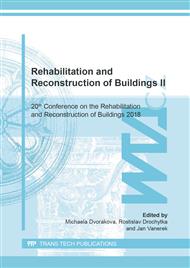p.82
p.88
p.93
p.103
p.109
p.115
p.123
p.129
p.136
Trenchless Sewer Rehabilitation Methods and Solving Diversity of Cured Sleeves Thickness
Abstract:
For the rehabilitation and renovation of sewerage and gutter networks, different methods and technologies have been introduced over the last half-century. The trenchless technologies are showing the greatest development. They are promoted for reasons of environmental friendliness, they do not restrict the space in the place of renovation and the implementation is fast. The paper focuses on specific material starting points for the use of trenchless methods. Trenchless methods do not generate waste from original pipelines. New pipes are installed in the existing pipeline, or a new pipeline pushes the old profile into the surrounding area. However, the new pipeline is not accessible for the traditional methodology of result control and product performance verification. Particularly for Cured-in-Place-Pipe (CIPP) methods, it is difficult to determine representative quantities for key features such as the thickness of the sanitary insets (sleeves) after curing, and it follows from practice that the measurements should be performed with a special spike gauge. CIPP products achieve all the final properties through the installation process in the existing pipeline. Simulation on semi-operative polygons is increasingly being used for research and verification of suitable representatives. Authors of the article began to address this issue in research, in collaboration with the company WOMBAT, s.r.o. when investigating the higher resistance of CIPP lining.
Info:
Periodical:
Pages:
109-114
Citation:
Online since:
June 2019
Authors:
Keywords:
Price:
Сopyright:
© 2019 Trans Tech Publications Ltd. All Rights Reserved
Share:
Citation:


